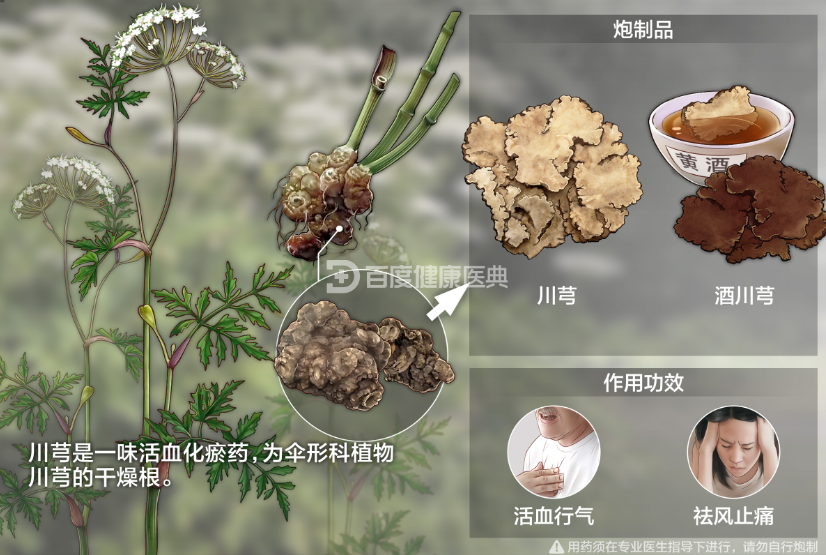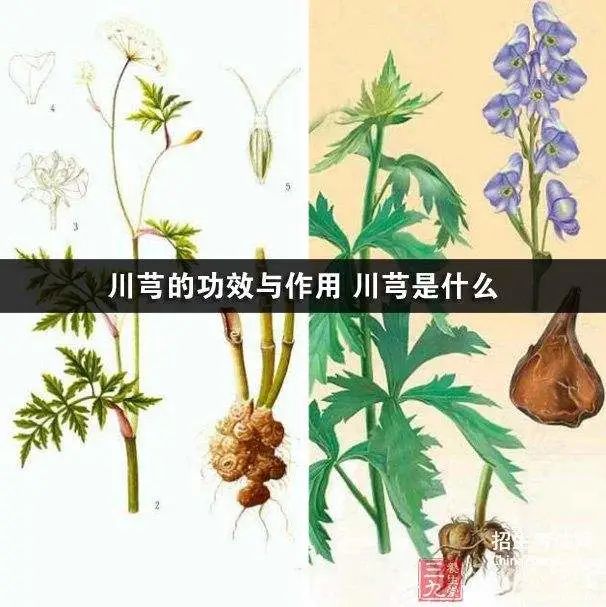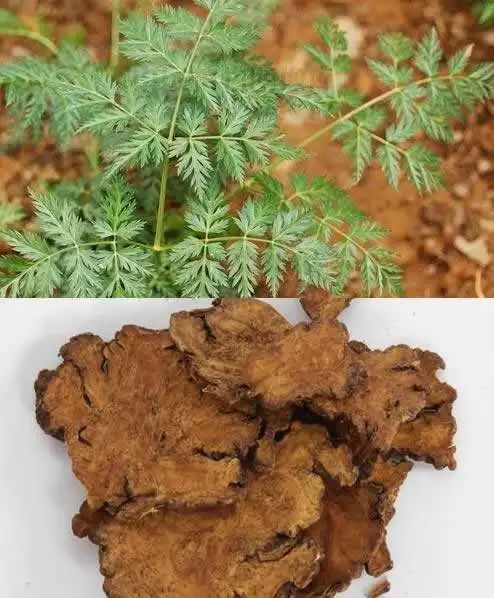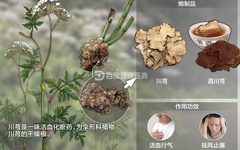| Chuanxiong (Rhizoma Chuanxiong) has the effects of promoting qi and resolving stasis, dispelling wind and drying dampness, invigorating blood and alleviating pain. It is a warm and pungent herb that enters the Liver (Gan) meridian, Gallbladder (Dan) meridian, and Sanjiao (Triple Burner) meridian. It is effective in treating headaches and dizziness caused by wind-cold evil. |
Doctors say:
Invigorating blood and dispelling stasis, dispelling wind and alleviating pain, calming the mind
First, for severe headaches, Chuanxiong is used to promote qi and relieve stagnation, applicable for various types of wind-cold headaches, migraines, and vascular headaches;
Second, it is used to invigorate blood and resolve stasis, frequently treating gynecological disorders, irregular menstruation, and amenorrhea;
Third, it is used to treat coronary heart disease, such as chest tightness, shortness of breath, and pain in the precordial area;
Fourth, it is often used in surgical conditions, such as trauma and injuries, to promote qi and invigorate blood.
Fifth, suitable population: those with blood stasis constitution, individuals with irregular menstruation, and headache patients.
Sixth, contraindicated populations: those with yin deficiency constitution, pregnant women, and patients with hypertension.
However, when using Chuanxiong, attention should be paid to several situations, such as in patients with hypertension, those with excessive yang, and those with yin deficiency and excess fire, where caution or compatibility in application is necessary. Chuanxiong is known as a qi herb in the blood, ascending to the vertex and descending to the feet, but it should be used according to the location of the disease and different compatibilities.
Seventh, not suitable for simultaneous consumption: Chuanxiong should not be consumed with spicy and irritating foods, as it may lead to gastrointestinal discomfort, causing abdominal pain and diarrhea.
Spicy and irritating foods
4. Method of consumption
Decoction
Take an appropriate amount of Chuanxiong, wash it clean, place it in a decoction vessel, add water, bring to a boil over high heat, then reduce to low heat and simmer for about 30 minutes, filtering out the residue before drinking. It can also be decocted with other herbs under the guidance of a physician.
Soaking in liquor
Take an appropriate amount of Chuanxiong, soak it in white liquor for about a week before drinking, with a daily intake of about 30ml, and this should be done under the guidance of a physician.

[Pharmacological Knowledge]
[Herb Name] Chuanxiong (Rhizoma Chuanxiong)
[Alias] Shanjuqiong, Xiongzhu, Xiangguo, Huxiang, Maxian, Xixiong, Guanxiong.
[English Name] Chuanxiong Rhizoma.
[Source] The rhizome of the plant Ligusticum chuanxiong Hort. from the Umbelliferae family.
[Plant Morphology] The plant height is 0.5 to 1 meter. The rhizome is thick, with significantly swollen nodes and short internodes. The stem is erect, with longitudinal grooves and branches. The basal leaves have petioles 10 to 20 cm long, and the leaf blades are ovate-triangular, 15 to 30 cm long and 10 to 15 cm wide, with 3 to 4 times pinnately compound lobes, 4 to 6 pairs of leaflets, and the terminal lobes are pinnately lobed. The stem leaves are similar to the basal leaves but simplified, without petioles, and once pinnately divided. The compound umbel is terminal or lateral, with a fruiting diameter of 6 to 8 cm. The total bracts are 5 to 6, linear, with 15 to 30 rays, nearly equal in length, 3 to 5 cm long, and the small total bracts are 5 to 8, linear, shorter than the flower stalks, and reflexed. The calyx teeth are undeveloped, the petals are white, obovate, with a wedge-shaped base, and the flower column is as long as the fruit, bending downwards. The fruit is oval-shaped, 2 to 3 mm long and 1.5 to 2 mm wide, with 1 to 3 oil tubes in the rib grooves and 4 to 6 oil tubes on the fused side. The flowering period is from July to August, and the fruiting period is from September to October.
[Distribution] It is widely cultivated in Sichuan.
[Harvesting and Processing] In the summer of the second year after planting, when the nodes on the stem are significantly protruding, the rhizomes are dug up, the soil is shaken off, the stems and leaves are removed, and then dried.
[Herb Characteristics] It is irregularly knobby, fist-shaped lumps, with a diameter of 2 to 7 cm. The surface is yellow-brown, rough, and wrinkled, with many parallel raised nodes, and the top has a depressed, round stem scar. The underside and nodes have many small tuberous root scars. The texture is solid and not easily broken, with a cross-section that is yellowish or grayish-yellow, scattered with yellow-brown oil chambers, and the growth rings are wavy. It has a strong aroma, a bitter and pungent taste, with a slight numbing sensation on the tongue and a mild sweetness aftertaste.
[Nature and Taste] Warm in nature, pungent in taste. It enters the Liver, Gallbladder, and Pericardium meridians.
[Efficacy and Function] Invigorates blood and promotes qi, dispels wind and alleviates pain. It belongs to the category of blood-invigorating and pain-relieving herbs.
[Clinical Applications] For internal use: decoction, 3 to 10 grams; powdered form, 1 to 1.5 grams per dose; or in pills or powders. For external use: appropriate amount, powdered and sprinkled, or used in a poultice, or decocted for gargling. It is used for chest obstruction and heart pain, stabbing pain in the chest and hypochondrium, swelling and pain from trauma, irregular menstruation, dysmenorrhea, abdominal pain from masses, headaches, and rheumatic pain.
[Pharmacological Research] Effects on the cardiovascular and cerebrovascular systems: it has an inhibitory effect on the heart; can dilate blood vessels and lower blood pressure; increases coronary blood flow; protects against myocardial and reperfusion injury; improves microcirculation; enhances cerebral circulation and alleviates cerebral ischemia. It improves the blood system, has diuretic effects, enhances the immune system; can inhibit bronchoconstriction caused by leukotrienes, histamine, and prostaglandin E2; can prevent and protect against epinephrine-induced pulmonary edema in experimental rats; has anti-tumor and anti-radiation effects.
[Chemical Components] The rhizome contains about 1% volatile oil. 40 components have been identified in the oil, accounting for 93.64% of the volatile oil, with the main components being ligustilide (58%), 3-butylidenephthalide (5.29%), and α-pinene (6.08%), as well as ferulic acid, chuanxiongine, 3-allylphenol, laurene, chuanxiongine, palmitic acid, carotenoids, β-sitosterol, and other components.

[Usage Contraindications] Excessive menstruation, pregnant women, and those with hemorrhagic diseases should use with caution; contraindicated for those with yin deficiency and excess fire.
[Related Formulas] For reference only
① For postpartum blood stasis and abdominal pain: 24 grams of Danggui (Angelica Sinensis), 9 grams of Chuanxiong, 14 pieces of Taoren (Peach Kernel) (peeled and pointed, ground), 1.5 grams of Hejiang (Black Ginger), and 1.5 grams of honey-fried licorice. Use equal parts of yellow wine and children’s urine for decoction. (From “Fu Qingzhu’s Gynecology” – Shenghua Decoction)
② For excessive postpartum bleeding and fainting: 15 grams of Chuanxiong, 15 grams of Danggui, and 15 grams of Jinge (Fried Black) are made into one dose, decocted in water, and taken with wine and children’s urine. (From “Song’s Gynecology Secret” – Chuanxiong Decoction)
③ For postpartum qi and blood deficiency, feeling wind-cold, headache with chills and fever: 6 grams each of Danggui and Chuanxiong, and 3 grams each of Zisu (Perilla) and dried Kudzu. Add three slices of ginger, decoct and take. (From “Yideng Xuyan” – Modified Xiong Gui Decoction)
④ For migraines and wind headaches: 9 grams each of Ganjuhua (Chrysanthemum), Shigao (Gypsum), and Chuanxiong, ground into powder. Take 3 grams each time, mixed with tea. (From “Chishui Xuanzhu” – Chuanxiong Powder)
⑤ For nasal congestion and inability to smell: 30 grams each of Chuanxiong and Xinyi (Magnolia Flower), 0.9 grams of Xixin (Asarum) (remove sprouts and leaves), and 15 grams of Mutong (Akebia). Grind the four ingredients into powder. Take a small amount, wrap in cotton and insert into the nose, changing when wet. (From “Shengji Zonglu” – Chuanxiong Powder)

Compound Preparations
Chuanxiong Tea Tiao Powder
Dispels wind and alleviates pain. For headaches caused by external wind evil, or with chills, fever, and nasal congestion.
Da Chuanxiong Oral Liquid
Invigorates blood and resolves stasis, calms the liver and extinguishes wind. For headaches, dizziness, neck tension, numbness in the limbs, or purple spots on the tongue caused by blood stasis.
Compound Chuanxiong Tablets
Invigorates blood and resolves stasis, opens the meridians and alleviates pain. For stable angina pectoris due to blood stasis.
Shu Xiong Capsules
Invigorates blood and resolves stasis, opens the meridians and alleviates pain. For chest obstruction due to blood stasis, presenting with chest tightness and stabbing pain in the precordial area; for patients with heart disease and angina pectoris with the above symptoms.
Tianshu Capsules
Invigorates blood and calms the liver, opens the meridians and alleviates pain. For chronic headaches due to blood stasis or excessive liver yang, or for dizziness, hypochondriac pain, insomnia, irritability, dark complexion, or purple spots; for vascular headaches, tension headaches, and headaches due to hypertension with the above symptoms.
Si Wu Decoction
Tonifies blood and regulates menstruation. For symptoms of blood deficiency and stagnation. Dizziness, palpitations, insomnia, pale complexion, irregular menstruation, or amenorrhea, abdominal pain, or masses, pale tongue, pale lips and nails, thin wiry or thin choppy pulse.
Shenghua Decoction
Tonifies blood and dispels stasis, alleviates pain. For blood deficiency and cold stagnation, or blood stasis. For postpartum lochia not flowing, and cold pain in the lower abdomen.
Chaihu Shugan Powder
Soothes the liver and promotes qi, alleviates pain. For liver qi stagnation. Pain in the hypochondrium, chest tightness, emotional depression, irritability, or belching, abdominal distension, wiry pulse.
Xuefu Zhuyu Decoction
Invigorates blood and resolves stasis, promotes qi and alleviates pain. For blood stasis in the chest. Chest pain, headache, persistent pain, stabbing pain with a fixed location, or prolonged hiccups, or choking on water, dry heaving, or palpitations, insomnia with vivid dreams, irritability.
Buyang Huanwu Decoction
Tonifies qi, invigorates blood, opens the meridians. For stroke with qi deficiency and blood stasis. Hemiplegia, facial droop, slurred speech, drooling, frequent urination or incontinence.
| =====Previous Classics=====Chinese Medicine – The Efficacy and Function of Seahorse, Warming the Kidney and Strengthening Yang, Dissolving Masses and Reducing SwellingChinese Medicine – The Efficacy and Contraindications of NiuxiThe Efficacy and Function of Burdock TeaChinese Medicine – The Efficacy of Deer Antler in Nourishing the Kidney and Strengthening Yang, Generating Essence and Nourishing Blood, Strengthening the Marrow and BonesChinese Medicine – The Efficacy and Function of WuyaoFive Types of Chinese Herbs Not to Be Used with AntibioticsChinese Medicine – The Efficacy and Function of Fengguidou GrassFormula: A Timeless Classic – Yupingfeng PowderChinese Medicine Collection (1)Health Science Popularization Collection (1)Kidney Deficiency or Not, Just Look at the Hands and Tongue!The Efficacy and Function of Coffee Beans, Not Just for Refreshment, but Also for Skin CareThe King of Anthocyanins – The Efficacy and Function of Black Chokeberry |
 Note:Please do not use medication without a doctor’s advice.
Note:Please do not use medication without a doctor’s advice.

